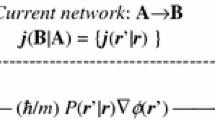Abstract
The implications of the Pauli exclusion principle for the entropy/informa- tion indices of the chemical bond formulated within the communication theory approach are explored. The spatial information channels in the local, two-electron resolution are derived for the singlet and triplet states of two electrons, modeling the chemical bonding and non-bonding states in a molecule, respectively. Their average conditional-entropy (covalency) and mutual-information (ionicity) descriptors are compared against those characterizing the separate atoms and an upper-bound to the information-theoretic bond-order for the molecular orbital “events” is determined. An illustrative application to AO channels in H2 generates numerical values of the information-theoretic indices for this prototype covalent bond. The molecular information systems are interpreted as the ensemble averages of the elementary deterministic (zero-covalency) information networks. Examples of such a channel synthesis include model binary channels and that representing the elementary valence-bond (VB) covalent structure in H2. The ensemble representation of the spin channel for the triplet state of two electrons, averaged over the three spin-projection components, offers an entropic perspective on the spin-pairing in the bond-formation process. The spin-paired (singlet) communication system is obtained by maximizing in the ensemble-average communication system of the triplet state the information-flow (ionicity) to its capacity level.
Similar content being viewed by others
References
R.A. Fisher, Proc. Cambridge Phil. Soc. 22, 700 (1925); see also: B.R. Frieden, Physics from the Fisher Information—A Unification (Cambridge University Press, Cambridge, 2000)
C.E. Shannon, Bell Syst. Tech. J. 27, 379, 623 (1948); see also: C.E. Shannon, W. Weaver, The Mathematical Theory of Communication (University of Illinois, Urbana, 1949)
S. Kullback, R.A. Leibler, Ann. Math. Stat. 22, 79 (1951); see also: S. Kullback, Information Theory and Statistics (Wiley, New York, 1959)
Abramson N.: Information Theory and Coding. McGraw-Hill, New York (1963)
R.F. Nalewajski, Information Theory of Molecular Systems (Elsevier, Amsterdam, 2006) and refs. therein; R.F. Nalewajski, Use of fisher information in quantum chemistry, Int. J. Quantum Chem. (K. Jankowski issue) (in press)
Nalewajski R.F.: J. Phys. Chem. A 104, 11940 (2000)
Nalewajski R.F.: Mol. Phys. 102(531), 547 (2004)
Nalewajski R.F.: Mol. Phys. 103, 451 (2005)
R.F. Nalewajski, Mol. Phys. 104, 493, 1977, 2533 (2006)
Nalewajski R.F.: Mol. Phys. 104, 365 (2006)
Nalewajski R.F.: Struct. Chem. 15, 391 (2004)
Nalewajski R.F.: J. Math. Chem. 38, 43 (2005)
Nalewajski R.F.: Theor. Chem. Acc. 114, 4 (2005)
R.F. Nalewajski, K. Jug, in: Reviews of Modern Quantum Chemistry: A Celebration of the Contributions of Robert G. Parr, vol. I, ed. by K.D. Sen (World Scientific, Singapore, 2002), p. 148
Nalewajski R.F.: Chem. Phys. Lett. 386, 265 (2004)
R.F. Nalewajski, J. Math. Chem. (in press), doi:10.1007/s10910-007-9345-4
R.F. Nalewajski, Mol. Phys. 104, 2533, 3339 (2006)
Nalewajski R.F.: J. Phys. Chem. A 111, 4855 (2007)
Nalewajski R.F.: J. Math. Chem. 43, 265 (2008)
Nalewajski R.F.: J. Math. Chem. 43, 780 (2008)
R.F. Nalewajski, J. Math. Chem. (in press), doi:10.1007/s10910-007-9318-7
W. Heitler, F. London, Z. Physik 44, 455 (1927); for an English translation see: H. Hettema, Quantum Chemistry Classic Scientific Paper (World Scientific, Singapore, 2000); F. London, Z. Phys. 455, 46 (1928)
Hirshfeld F.L.: Theor. Chim. Acta. (Berl.) 44, 129 (1977)
Nalewajski R.F., Broniatowska E.: Theor. Chem. Acc. 117, 7 (2007)
Nalewajski R.F., Broniatowska E.: J. Phys. Chem. A 107, 6270 (2003)
R.F. Nalewajski, J. Math. Chem. (in press), doi:10.1007/s10910-008-9385-4
Author information
Authors and Affiliations
Corresponding author
Rights and permissions
About this article
Cite this article
Nalewajski, R.F. Manifestations of Pauli exclusion principle in communication-theory of the chemical bond. J Math Chem 45, 776–789 (2009). https://doi.org/10.1007/s10910-008-9380-9
Received:
Accepted:
Published:
Issue Date:
DOI: https://doi.org/10.1007/s10910-008-9380-9




